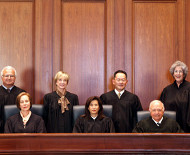Article from: www.thenewspaper.com/news/42/4271.asp
11/29/2013
California Supreme Court Outlaws Science In DUI Cases
Scientific evidence challenging the accuracy of breathalyzers is not admissible, California Supreme Court rules.
 Scientific evidence cannot be brought into evidence to challenge a borderline conviction for driving under the influence of alcohol (DUI) in California. The state Supreme Court last week rejected Terry Vangelder's attempt to clear his name after he was arrested for drunk driving though he showed few signs of impairment in field sobriety tests.
Scientific evidence cannot be brought into evidence to challenge a borderline conviction for driving under the influence of alcohol (DUI) in California. The state Supreme Court last week rejected Terry Vangelder's attempt to clear his name after he was arrested for drunk driving though he showed few signs of impairment in field sobriety tests.
California Highway Patrol Sergeant Richard W. Berg noticed Vangelder's pickup truck driving at an alleged 125 MPH on Highway 163 in San Diego County on December 22, 2007. As soon as Sergeant Berg flipped on his overhead lights, Vangelder pulled over. Vangelder admitted to having a few glasses of wine with dinner, so he took and passed the field sobriety tests. Vangelder agreed to take a handheld Intoximeter Alco-Sensor IV preliminary alcohol screener test, which displayed a 0.086 blood alcohol content (BAC) reading. After this, he was arrested and taken to the county jail where an Intoximeter EC/IR breatalyzer produced an 0.08 BAC reading, right at the legal limit. He then took a blood test that reported a 0.087 BAC.
"I said I wanted to submit to a blood test," Vangelder testified. "I didn't think it was accurate. And the reason I say that is because I knew how much I had to drink."
At trial, Vangelder called Dr. Michael P. Hlastala, a professor of medicine at the University of Washington, to testify. Hlastala is the author of a textbook and 170 peer-reviewed articles on the physiology of alcohol. He testified that the breath machines do not produce a scientifically reliable result. When he gave a very detailed explanation of how the machines fail to measure the alcohol content of deep lung air, the prosecutor objected and the jury was sent out of the courtroom.
"They are (inaccurate)," Dr. Hlastala testified before the judge. "And primarily because the basic assumption that all of the manufacturers have used is that the breath that [is] measured is directly related to water in the lungs, which is directly related to what's in the blood. And in recent years, we've learned that, in fact, that's not the case."
The professor explained that the machine reading can change based on the speed and depth of breathing, body and breath temperature, and the ratio of red blood cells to total blood volume. These factors could lead to the reading either overstating or understating the true alcohol content of the blood.
"The question of whether the breath [sample and result] accurately reflects anything else is irrelevant," the prosecutor countered.
The prosecution then moved to strike all of the expert witness testimony that would suggest there was something wrong with the way California drafted its laws. The trial judge ruled that general scientific arguments could not be made and that the defense could only present evidence that a particular machine had malfunctioned. Under a California law adopted in 1990, a motorist is guilty of DUI if he blows a 0.08 on a breath testing machine, regardless of whether he is physically impaired or not.
"As noted earlier, we explained in Bransford, that the 1990 amendment of the per se offense was specifically designed to obviate the need for conversion of breath results into blood results -- and it rendered irrelevant and inadmissible defense expert testimony regarding partition ratio variability among different individuals or at different times for the same individual," Chief Justice Tani Gorre Cantil-Sakauye wrote for the court. "Whether or not that part of expired breath accurately reflects the alcohol that is present only in the alveolar region of the lungs, the statutorily proscribed amount of alcohol in expired breath corresponds to the statutorily proscribed amount of alcohol in blood, as established by the per se statute."
The high court explained that city, state and federal agencies around the country use and have tested the machines, and they work. The court argued the legislature took into account the way breath works when it passed the law to deny scientific challenges to the machines.
"We conclude that when the legislature employed the word 'breath' in section 23152(b), it had in mind the air that is exhaled into a properly working and calibrated breath-testing machine," Justice Cantil-Sakauye wrote. "Although Dr. Hlastala may hold scientifically based reservations concerning these legislative conclusions, we must defer to and honor the legislature's reasonable determinations made in the course of its efforts to protect the safety and welfare of the public."
The court found that the scientific evidence could be used to challenge a general DUI charge, but it could not be used to challenge the per se DUI charge.
A copy of the decision is available in a 350k PDF file at the source link below.
Source: California v. Vangelder (California Supreme Court, 11/21/2013)
Permanent Link for this item
Return to Front Page
 Scientific evidence cannot be brought into evidence to challenge a borderline conviction for driving under the influence of alcohol (DUI) in California. The state Supreme Court last week rejected Terry Vangelder's attempt to clear his name after he was arrested for drunk driving though he showed few signs of impairment in field sobriety tests.
Scientific evidence cannot be brought into evidence to challenge a borderline conviction for driving under the influence of alcohol (DUI) in California. The state Supreme Court last week rejected Terry Vangelder's attempt to clear his name after he was arrested for drunk driving though he showed few signs of impairment in field sobriety tests.